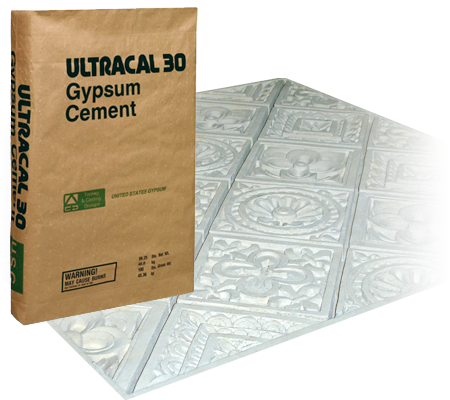USG
Ultracal® 30
Ultracal® 30
11 in stock
Couldn't load pickup availability
AVAILABLE IN 5, 25, AND 50LB OPTIONS IN THE DROPDOWN
USG Ultracal® Brand 30 Gypsum Cement is designed for the patternmaking industry as the
ultimate gypsum cement tooling medium. When extreme accuracy and greater surface hardness
are required (as in duplicator models), use USG Ultracal 30 Gypsum Cement. It provides extremely
low expansion properties, gradual set and a long period of plasticity.
Ideal for splash-casting molds and models for phenolic, polyester and epoxy resins, USG Ultracal 30
Gypsum Cement is water soluble – there is no need for organic solvents for cleanup. USG Ultracal
30 Gypsum Cement is noncombustible. When properly used, USG Ultracal 30 Gypsum Cement is
easy to work with. Always follow handling and use directions and safety warnings on the package.
MIXING INSTRUCTIONS
Use potable water at temperatures between 70 °F (21 °C) and 100 °F (38 °C). Because variations
in slurry (USG Ultracal 30 Gypsum Cement and water mixture) temperature produce variations in
set time, it is important to keep both the USG Ultracal 30 Gypsum Cement and water in a stable
temperature environment prior to use. The higher the temperature of the slurry, the shorter the set
time. Conversely, the lower the temperature of the slurry, the longer the set time.
Weigh both the USG Ultracal 30 Gypsum Cement and the water prior to use for each mix. The
water-to-USG Ultracal 30 Gypsum Cement ratio is critical because it governs the strength and the
density of the final cast.
Sift or strew USG Ultracal 30 Gypsum Cement into the water slowly and evenly. Do not drop large
amounts of USG Ultracal 30 Gypsum Cement directly into the water as proper soaking of the
USG Ultracal 30 Gypsum Cement may not occur. USG Ultracal 30 Gypsum Cement should be fully
dispersed in the water prior to mixing. Small batches require less soaking time than large batches.
See USG IG503 Plaster Mixing Procedures for specific soaking instructions.
Mixing USG Ultracal 30 Gypsum Cement slurry is one of the most important steps in producing
USG Ultracal 30 Gypsum Cement casts with optimal strength, absorption, hardness and other
important properties.
Mechanically mixed slurries develop uniform casts with optimal strengths. USG Ultracal 30 Gypsum
Cement can be mechanically mixed through both batch and continuous processes. Proper blade
and bucket dimensions are important for obtaining the best batch mix (see USG IG503 Plaster
Mixing Procedures for details).
Longer mixing times result in higher mold strength and shorter set times.
POURING
To prevent air entrainment and provide a uniform, smooth surface, careful pouring of USG
Ultracal 30 Gypsum Cement slurry is necessary. Agitation of the filled mold is a further step used
to prevent air at or near the mold surface. Whenever possible, USG Ultracal 30 Gypsum Cement
slurry should be poured carefully in the deepest area so that the slurry flows evenly across the
surface of the case mold.
Pouring a large amount of slurry directly on the face of the case mold may result in slight
densification of the USG Ultracal 30 Gypsum Cement mold at the point where it strikes the surface
of the case. This produces a hard spot, giving uneven absorption.
DRYING
All casts should be dried as quickly as is safely possible after manufacture so that maximum
physical properties can develop. Dry to a constant weight.
The best drying rooms or ovens provide 1) uniform and rapid circulation (minimum of 15-30 fps
(4.6-9.1 mps)) of air with no “dead spots” having little or no air movement, 2) equal temperatures
throughout the entire area, and 3) provisions for exhausting a portion of the air while replacing
it with fresh air. High humidity surrounding the drying room or oven inhibits drying efficiency
because the air pulled into the room is incapable of picking up much moisture from the molds.
The maximum temperature at which USG Ultracal 30 Gypsum Cement molds are safe from
calcination is 120 °F (49 °C). With substantial free water in the mold, a higher drying temperature
can be used initially without difficulty. As drying progresses, the temperature must be reduced to
prevent calcination. Before removing molds from the dryer, the temperature should approach that
of the area around the dryer to prevent thermal shock.
STORAGE AND USE
When properly used, USG Ultracal 30 Gypsum Cement is easy to work with. Keep indoors at
temperatures between 65 °F - 75 °F (18 °C - 24 °C) and 45% - 55% RH. Do not stack more than
two pallets high. Keep from drafts. Rotate stock. USG Ultracal 30 Gypsum Cement should be used
within 6 months of the manufacturing date located on the package. Always follow handling and
use directions and safety warnings on the package.
Share


- Choosing a selection results in a full page refresh.
- Opens in a new window.


